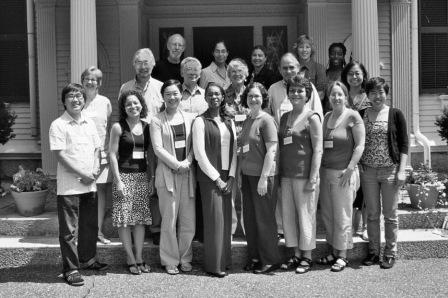Racial/ethnic self-identification can vary over time and place, in other words, some adolescents of mixed ancestry report different single-race or mixed-race identifications at different times and in different situations. This report seeks to explore whether adolescents of mixed-ancestry have particular strengths or weaknesses compared within their single-race-reporting peers.
 Racial/ethnic self-identification can vary over time and place, in other words, some adolescents of mixed ancestry report different single-race or mixed-race identifications at different times and in different situations. This study developed a latent modeling approach to assess mixed heritage. Just as any single measure is error prone, and particularly because racial/ethnic identification claims are fluid, any single-item assessment of racial/ethnic heritage can be even more error prone. In practical terms, individuals who claim to belong to a single-heritage group may claim more than one heritage on another occasion or when asked in a different way. Based on a single item, it is not possible to know whether an individual claiming single heritage will report mixed heritage at another time or in another context and vice versa. The latent variable approach can shift the way researchers approach the identification of mixed heritage by combining information from several dimensions of heritage simultaneously. The greater precision of the latent variable approach affords can bring cohesion to empirical studies that have been plagued with inconsistent findings. With respect to clinical practice, the latent variable approach has the potential to identify hidden populations that have been underserved. Also, information on the strengths and vulnerabilities of different racial/ethnic combinations may help discourage health and social services providers from making sweeping generalizations to all mixed-heritage adolescents.
Racial/ethnic self-identification can vary over time and place, in other words, some adolescents of mixed ancestry report different single-race or mixed-race identifications at different times and in different situations. This study developed a latent modeling approach to assess mixed heritage. Just as any single measure is error prone, and particularly because racial/ethnic identification claims are fluid, any single-item assessment of racial/ethnic heritage can be even more error prone. In practical terms, individuals who claim to belong to a single-heritage group may claim more than one heritage on another occasion or when asked in a different way. Based on a single item, it is not possible to know whether an individual claiming single heritage will report mixed heritage at another time or in another context and vice versa. The latent variable approach can shift the way researchers approach the identification of mixed heritage by combining information from several dimensions of heritage simultaneously. The greater precision of the latent variable approach affords can bring cohesion to empirical studies that have been plagued with inconsistent findings. With respect to clinical practice, the latent variable approach has the potential to identify hidden populations that have been underserved. Also, information on the strengths and vulnerabilities of different racial/ethnic combinations may help discourage health and social services providers from making sweeping generalizations to all mixed-heritage adolescents.
The measurement pilot proceeded in two phases. Initially, the total student body of 3 high schools in the Northeastern United States was asked to complete a screening survey. During the second phase in-depth interviews took place with students whose responses to the screening survey indicated that they had the potential to identify themselves as having a mixed racial/ethnic identity. The outcome of the measurement pilot will inform a nationwide longitudinal study of mixed-ancestry identity development planned for the future.
The study was carried out by a diverse team of social scientists all of whom have experience with research on racial and ethnic minority populations. Sumru Erkut, Michelle Porche Allison Tracy lead the team and they were joined by Heidie Vázquez García, Jo H. Kim, Jennifer Grossman Linda Charmaraman, Ineke Ceder, and Ashley Quach. The researchers employed Peony Fhagen-Smith’s Mixed Ancestry Racial/Ethnic Identity Development (MAREID) Model as the framework for the research.
Members of the Mixed Ancestry research team, Tracy, Erkut, Porche, Kim, Charmaraman, Grossman, Ceder, and Váquez García, co-authored an article “Measurement Uncertainty in Racial and Ethnic Identification among Adolescents of Mixed Ancestry,” published in Structural Equation Modeling (2010). This paper operationalizes the identification of mixed ancestry among adolescents as a latent variable, and contrasts multiple ways of measuring mixed ancestry. An extension of this work uses the latent variable approach to examine adolescents with inconsistent or ambiguous race and ethnicity responses. Our preliminary findings show that these adolescents report poorer wellbeing outcomes (higher depression & lower cognitive flexibility) than do adolescents returning clearly monoracial or clearly multiracial responses.
Related research from this study investigating adolescents’ explanations of racial centrality has resulted in a paper, “Race, context, and privilege: White adolescents’ explanations of racial centrality” by Grossman and Charmaraman, which was published in a special issue of the Journal of Youth and Adolescence(2009) entitled “The Place of Race in Adolescence.” A second paper by Charmaraman and Grossman, which explores racial centrality among adolescents of color, is in press with the journal Cultural Diversity and Ethnic Minority Psychology (2010).
The team was assisted by an Advisory Board made up of prominent scholars in the fields of racial and ethnic studies and mixed ancestry: Jenifer Bratter, William E. Cross, Jr., Richard Lee, Jonathan Okamura, Michael Omi, Jean Phinney, Kerry Ann Rockquemore, Matthew Snipp, and Mary C. Waters.



